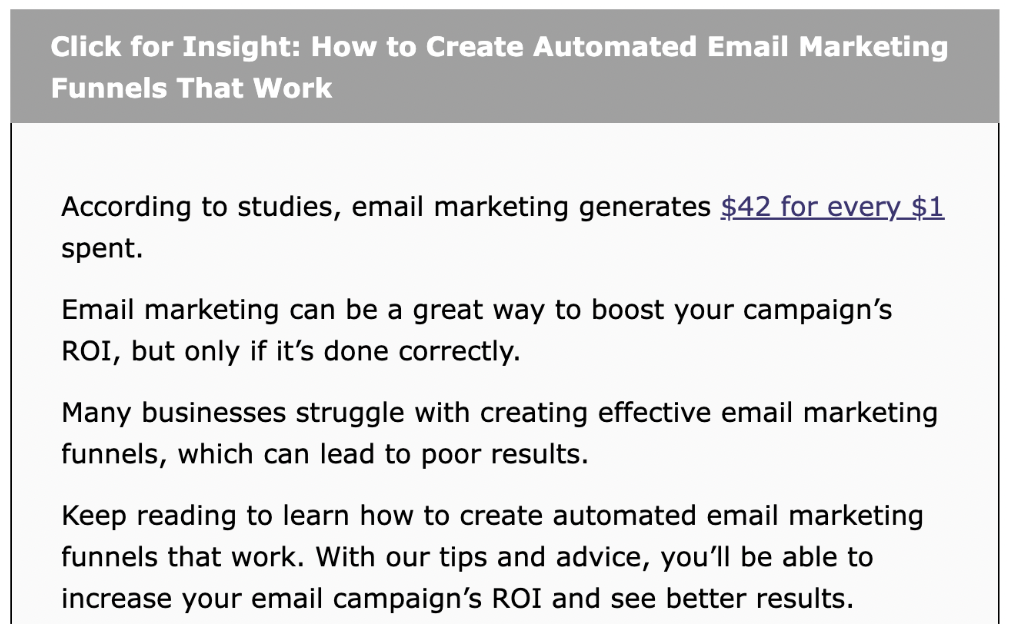Case study: Don’t write "how-to" articles that aren't helpful
There are probably hundreds of millions of marketing-related articles out on the internet. A big portion of those articles are "how-to" guides for various activities us marketing types like to encourage business owners like you to implement.
The problem is that way too many of these articles are like this one and have little to no real value in them.
While the article promises to deliver information on how to create automated email marketing funnels “that work,” (already a vague commitment to the reader), it does little to provide tangible steps and instead gives general ideas and suggestions the reader likely already knows.
Let's break the points in this article down and instead review what real value looks like.
Choose the right software
This section on its own could be an entire article. Choosing the right software to deliver email campaigns isn’t straightforward!
There are a number of considerations to take into account, including what other software applications you use and how these will work together with your email marketing plans, your website setup, the short- and long-term email and automation needs you have, the usability of the software you're looking at, your resources, and let's not forget your budget.
This article briefly mentions two specific product options before concluding that the best software will depend on your needs and budget, without actually listing what needs you might have.
Before you sign up for email software, you want to be confident in your marketing goals, and how you want to use the software within your business.
How often are you going to be sending emails? If it’s quite regularly you may not want to sign-up for software that charges you based on the number of emails or automations you set-up.
How large is your email list currently? How big do you see it getting, and how quickly? If these numbers are quite large, you want to ensure your chosen software provides room for growth.
How will you collect leads? Ensure the software you choose provides proper forms, links, and sign-up opportunities based on where you plan on promoting your email list.
Getting clear on each of these components of your email marketing strategy is how you can determine the right software, and the right tier of the software for your business.
Identify the stages of your funnel
I’ve spoken to many business owners who only vaguely understand what a funnel is, and without a marketing background, they're at a loss on where to begin.
This section is also a whole post (or course) of its own.
While this article encourages readers to start to get clear on their customer journey (the steps someone takes to become a customer), which is a good start, it stops there.
The problem is, many business owners don't know how to align their products within the funnel or how to determine what stage of the funnel various content is most appropriate.
Not to mention that bringing on a client isn't always a linear process!
Instead of trying to determine one path for each of your potential clients to follow, make a list of all of the different opportunities people have to become aware of your brand.
Are you appearing on podcasts as a guest or do you have a podcast of your own? Are you showing up on different social media platforms? Are you attending events and handing out business cards? Are current clients sending referrals your way?
Once you have a list of these entry points, look at your offers.
From here you can outline how someone might move from becoming initially aware of you, to purchasing one of your offers.
Also consider how you might be able to provide additional value to this audience member, so that they’re more likely to buy.
Is there a free offer you can provide that would lead someone to purchase your paid offer?
Introduce yourself and your brand! Why should they trust you?
What questions or hesitations might someone have that you can eliminate so they have no reason not to buy?
Would a consult call support potential clients in making a decision? Do you have the capacity to provide those?
What is that person struggling with? How can you provide them value where they’re at? How can you speak to them using their language, and let them know you’ve been where they are?
How much time might someone need to get to know you and your offer before they’re ready to purchase? As a general rule, the more expensive an offer, the more value you need to provide before someone will buy. (However, there are always exceptions so make sure people have the opportunity before if they’re ready!)
Working backwards from the presentation of your offer, you can develop a sequence of emails that will gradually lead someone from initial introduction, to confident consumer.
This article provides a far more clear example of an email funnel that would provide value for the reader, and this graphic outlines the customer journey in a more concise and descriptive way.
Both offer far more value than an article introducing funnels without taking the time to explain them.
Via Campaign Monitor
Create engaging content
Engaging, valuable, helpful, useful, customer-centric, etc., etc., etc. We marketers use these words so much they almost have no meaning anymore! And yet the statement is still true.
Like the other two points, this could be a whole post (and is often a whole course) on its own.
But in this particular blog post, it would be much more helpful if there were examples of “engaging content” or a description of what a series of emails might focus on, rather than simply stating that no one wants to read boring or repetitive content. (A little ironic that they’re even suggesting this, isn’t it?)
For example, many readers would find it much more valuable to see a break-down like:
Email 1: This email would be delivered after someone opts in to receive your free download. Start by thanking your reader for their interest in <insert offer> and provide a CTA (call-to-action) to download said offer in a clear and concise manner.
Email 2: This email is a good opportunity to check-in with your readers so you stay fresh in their mind. Introduce yourself to them. Ask them how things are going, and highlight something from your initial offer so that they’re reminded to open or implement it. At the bottom, include a CTA such as encouraging your readers to reply to the email if they have any questions or if they’d like to share why they were interested in your offer.
Email 3: If people have stayed on your email list and are continuing to open your emails, they’re great potential leads. Consider providing them with a second offer, letting them know that if they enjoyed <insert first offer> they’ll definitely find value in <insert second offer>. Then, include a CTA to check out the second offer!
This is a very basic sequence, but it gives some clear direction to anyone reading it. Including some sample copy? Even better.
Test and tweak
The article we’re referencing tells the reader to test their funnel, but fails to provide instruction on how to do so.
Essentially, this is as simple as turning the email sequence automation on and using a test email address to trigger the start of the automation so you can see that everything is sending according to your plan.
But, even that is just about making sure all the steps in your automation are working.
What about A/B split testing to further optimize over time?
This is trickier to explain, and I wouldn't dare try to provide step-by-step instructions for every potential tool people are using (that's what knowledge-base articles are for).
BUT this is a big consideration to have simply left out of the article.
A/B testing (or split testing), at its most basic level, is a way to compare different versions of a single component of an email to see which performs better. (That single component part is actually really important. If you try to A/B test two different subject lines AND content - how do you know which of those changes had an impact? Well…you won’t. A/B testing only works if you leave everything the same except for one aspect.)
For example, if you were split testing an email campaign, you might send the same email with two different subject lines to separate segments of your audience to see which version gets a higher open rate.
Over time, split testing (when done right) can help you refine your campaign to receive even more of the conversions you’re hoping for.
Keep it fresh
This explanation is pretty helpful, actually. The section describes that, as with all marketing tactics, email marketing funnels need to be refreshed regularly to keep recipients interested.
It also provides a few examples of how to do said refresh, such as adding new blog posts, images, graphics, or ebooks to your funnel.
The main thing that's missing from this section is some guidelines.
For example, to ensure your marketing automations are always fresh, you should set timelines to review them. This is going to depend on your business, as well as the content in your automation.
Do you need to refresh it every quarter? Every six months? Every year?
The more evergreen the content, the longer you can go between reviews, but in general my guidelines are as follows:
Review the content every time you make a change to the service or product, every time you change your process, and/or each time you shift the terminology you're using.
Review the content once a year at a minimum.
Implement automated email marketing today
This is a strong heading to conclude with, but the article doesn't deliver enough value (in my humble opinion) to put you on the right course to do what they're encouraging.
I also want to point out that it can take weeks and months to work through the steps to creating a really good marketing automation. So, it's okay if you can't get it done today.
This article makes this seem deceptively simple when in reality I've worked with many clients who struggle with the technology of setting up automated emails, don’t know how to link to documents, and/or find it challenging to know what to say in their emails.
(Let alone doing your due diligence to test and retest the automations that you do set-up.)
Strut your stuff in the best possible way
If your content is leaving your audience with more questions than answers, you likely haven't produced truly helpful content.
How-to articles can be a goldmine for organic traffic within your expertise.
But if you have people take the time to click on and read your article, only to provide them with little to no information, readers are going to be frustrated and are unlikely to return to your site.
So, when you're putting together content, make sure it's giving new visitors a stellar impression of who you are and what you know.
Put yourself in your reader’s shoes, answer their questions, use their language, and ensure you’re providing guidelines and examples where it makes sense.
If you want help figuring out how to do things like automations and connecting your various technology tools, join the Magnificent Marketers Club today! Every month, you can join our Tech Troubleshooting Session to get support that makes running your business easier.



